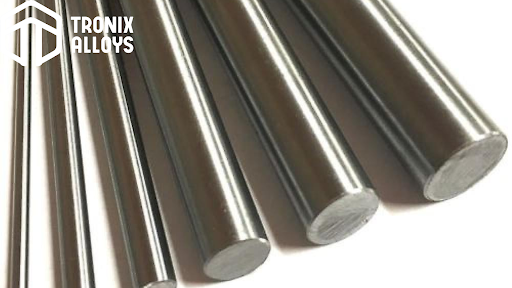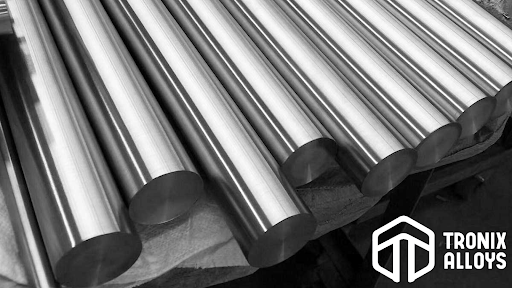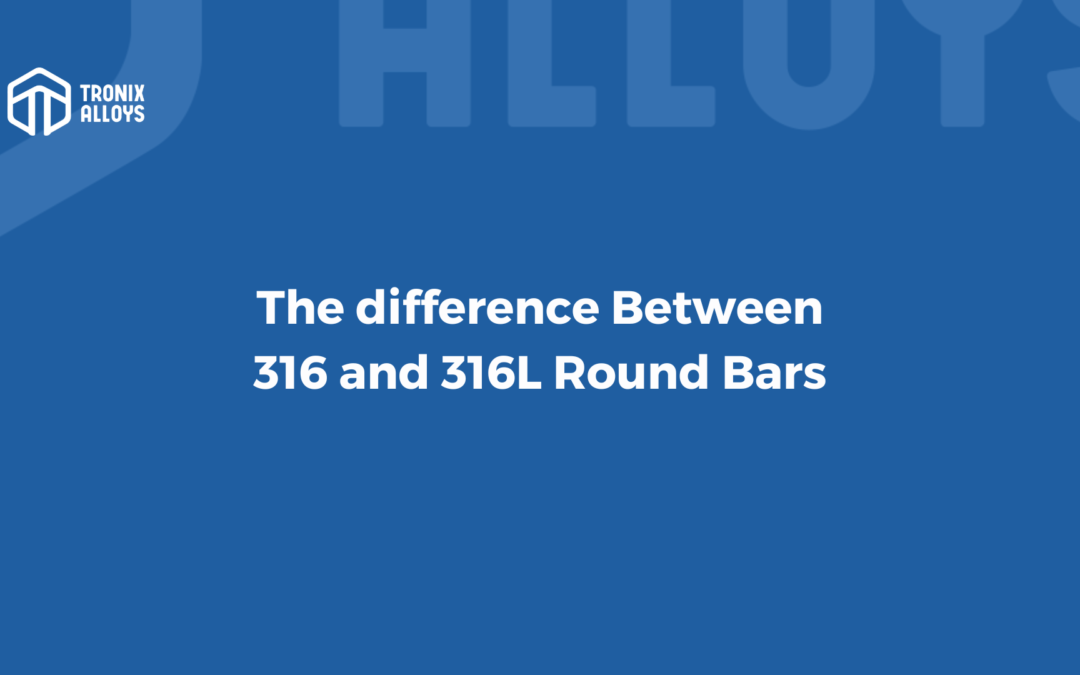
Definition of Stainless Steel
Although stainless steel consists mainly of iron and carbon, it also contains at least 10.5% chrome, a metallic element that contributes to its corrosion resistance and finish. The stainless steel alloy is ideal for long-term applications that are subjected to the elements, moisture, and potentially corrosive chemicals in addition to the elements. There is also a much lower risk of contamination in sensitive industries such as food preparation and pharmaceuticals.
It is important to note that different grades of stainless steel contain traces of different elements as well. In addition to appliances, cookware, tubing, and hardware applications, grade 304 stainless steel contains up to 35% nickel. 316 is ideal for marine equipment, chemical and pharmaceutical manufacturing equipment, and commercial kitchen equipment because it contains molybdenum.
Qualities of 316 vs. 316L Stainless Steel Round Bar
There are several important differences between bar 316 and 316L stainless steel alloys, even though both are marine-grade steels. The carbon content of 316L stainless steel alloy must not exceed 0.03% to qualify as 316L stainless steel. As a result, carbon precipitation is less likely, making it a good welding material for corrosion resistance.
There is a middle carbon content in this stainless steel, and it contains 2% to 3% molybdenum, both of which increase corrosion resistance, acidic element resistance, and high temperature resistance. Both materials are highly malleable, making them ideal for bending, stretching, drawing deep into the air, and spinning. 316 grade stainless steel has almost the same physical and mechanical properties as 304 stainless steel, and it contains a similar material make-up..
How to Choose Between 316 Stainless Steel Round Bar or 316L Stainless Steel Round Bar
Consider the following factors when deciding whether to use 316 stainless steel or 316L stainless steel for your application:
Corrosion Resistance
316L stainless steel is a good choice for high-corrosion and high-temperature applications for a number of reasons. Because 316L contains less carbon than 316, it has better intergranular corrosion resistance, so unlike 316 bar Stainless Steel, its welds won’t decay.
Cost
In spite of 316L’s lower carbon content, 316 stainless steel rod costs about the same as 316 stainless steel.
Magnetic Properties
Although basic stainless steels are ferromagnetic, many varieties, including 316 stainless steel, are austenitic, or effectively nonmagnetic, making them very insensitive to magnetic fields.
316L steel is more prone to acquiring magnetic properties because its austenitic structure is transformed into ferromagnetic martensite by processes such as cold forming and welding.
Practical Applications

Because 316 stainless steel is extremely strong, pitting-resistant, and corrosion-resistant in most circumstances, it is primarily used in construction and infrastructure. Stainless steels can both serve a wide range of purposes in addition to being useful in a wide range of industries. 316L is a popular material in the pharmaceutical and photography industries because it is resistant to welding and corrosion.
WELDING CHARACTERISTICS:
This alloy can be welded using any standard welding method, and there is no need to heat treat it after welding, and the oxyacetylene process cannot be used.
If you would like to weld, you can use filler metals with much higher molybdenum contents than the base metals, or even without filler metals. It is generally not necessary to anneal Grade 316 L post-weld, but some of the heavy weld sections of Grade 316 do need annealing after welding in order to maximize corrosion resistance.
HEAT TREATMENT:
The internal stresses in an alloy are removed in the process of annealing. For the first two hours, type 316/316L should be heated at 1800°F and then quenched in water. However, it cannot be hardened by heat treatment. The alloy cannot be hardened by heat treatment in this type.
PROCESSING – HOT FORMING:
Forging, annealing, and steelmaking are some methods of hot working alloys. These processes are carried out at high temperatures between 1700 and 2200 degrees Fahrenheit. Forgings can then be heated to 1900 degrees Fahrenheit further. This process allows the alloy to recrystallize because it can be physically deformed.
PROCESSING- COLD FORMING:
Using the cold working process, the alloy can be formed and fabricated easily. In order to increase the strength and hardness of the material, several steps are involved in this process, including squeezing, bending, shearing, drawing, upsetting, and heading. Despite the fact that the material is initially nonmagnetic, it can gain some magnetic properties during this process.
MACHINABILITY:
Due to work hardening, the alloy has efficient operation, slow speed, outstanding lubrication, heavier feeds, acute tooling, durable and robust equipment, easy handling, and a long life expectancy.
CORROSION RESISTANCE:
As a result of its molybdenum composition, it is corrosion resistant in halide and chloride-containing environments and atmospheric environments. Molybdenum enhances its corrosion resistance in environments containing chloride and other halides. The addition of molybdenum improves pitting and crevice corrosion in chloride and other halide-containing environments.
It is possible to detect surface corrosion sometimes, which appears as faint brown stains and usually occurs as a result of cracks and rough surface finishes. It is also resistant to drinking water with chloride concentrations of up to 1000 mg/liter at ambient temperatures.
As-welded stainless steel has a corrosion resistance of almost 100% in the as-welded condition, so it has the kind of reliability that most process industries increasingly seek when handling many chemicals. Although it does not resist warm seawater, it is sometimes referred to as “marine grade 316 stainless steel”.
HEAT RESISTANCE:
A Its typical applications include structural, pressure-containing, and pressure-contraining applications. Due to its excellent creep resistance, grade 316/316L can also be very strong at higher temperatures. Scaling resistance is usually provided by an oxide layer that is formed during the manufacturing process.
Additionally, the alloy has a stable microstructure and a high mechanical load, which make it heat resistant. In the case of intermittent exposures of 870°C and continuous exposures of 925°C, the alloy has been shown to show excellent oxidation resistance. When applying water continuously at temperatures between 425-860 °C, it is advisable to avoid continuous applications. Furthermore, this product is resistant to carbide precipitation and water corrosion.
DUAL CERTIFICATION:
Due to the fact that 316 stainless steel is used for both plates and pipes, it is classified as a “Dual Certified Type.” Both 316L and 316S stainless steel are available in plates and pipes with specifications that specify their mechanical and chemical properties.
It is also noted that due to the discrepancy within the high temperature application, the certification has not been extended to type 31. It is also noted that due to the discrepancy within the high temperature application, the certification has not been extended to type 31.
APPLICATIONS:
Benches and equipment for the laboratories:
As a result of its easy maintenance and multipurpose nature, this alloy is an excellent choice for laboratory equipment and benches.
Food and Beverage industry:
This type of material can be very useful in the food and beverage industry, from storage to transportation, as well as easy cleaning and sterilization. Grade 316L is known as a corrosion-resistant material.
Heat exchangers:
As a result of its corrosion resistance and hardness, Grade 316/316L metal is an excellent choice for heat exchangers.
Textile industry:
Due to its inherent properties of strength and resistance, this type of stainless steel resists deterioration and performs well in the textile industry.
Petrol industry:
For example, grade 316/316L is well known for its ability to form oxide layers which inhibit the oxidation process of the metal, making it ideal for use in the petrol industry. As a result of its high heat resistance, the alloy can also be used in the petrol industry.
Nuclear reactors:
In As part of the nuclear industry, grade 316/316 L plays a major role. Nuclear power stations use the highest quality materials to ensure their reactors operate safely and their chemical reactions are safe.
Since the alloy is corrosion resistant, can withstand extreme temperatures, is very durable and has immense strength, it is a great choice for nuclear power plants. A further benefit of this alloy is its high mechanical formability.

